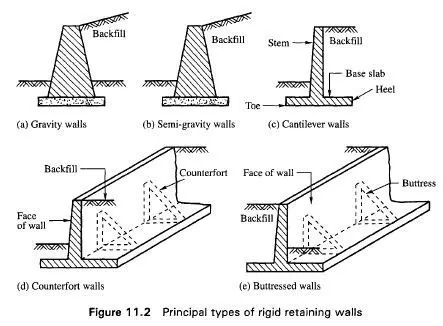There are two classical earth pressure theories. They are
1. Coulomb’s earth pressure theory.
2. Rankine’s earth pressure theory.
The first rigorous analysis of the problem of lateral earth pressure was published by Coulomb in (1776). Rankine (1857) proposed a different approach to the problem. These theories propose to estimate the magnitudes of two pressures called active earth pressure and passive earth pressure as explained below.
Consider a rigid retaining wall with a plane vertical face, as shown in Fig. 11.3(a), is backfilled with cohesionless soil. If the wall does not move even after back filling, the pressure exerted on the wall is termed as pressure for the at rest condition of the wall. If suppose the wall gradually rotates about point A and moves away from the backfill, the unit pressure on the wall is gradually reduced and after a particular displacement of the wall at the top, the pressure reaches a constant value. The pressure is the minimum possible. This pressure is termed the active pressure since the weight of the backfill is responsible for the movement of the wall. If the wall is smooth, the resultant pressure acts normal to the face of the wall. If the wall is rough, it makes an angle <5 with the normal on the wall. The angle 8 is called the angle of wall friction. As the wall moves away from the backfill, the soil tends to move forward. When the wall movement is sufficient, a soil mass of weight W ruptures along surface ADC shown in Fig. 11.3(a). This surface is slightly curved. If the surface is assumed to be a plane surface AC, analysis would indicate that this surface would make an angle of 45° + 0/2 with the horizontal.

If the wall is now rotated about A towards the backfill, the actual failure plane ADC is also a curved surface [Fig. 11.3(b)]. However, if the failure surface is approximated as a plane AC, this makes an angle 45° – 0/2 with the horizontal and the pressure on the wall increases from the value of the at rest condition to the maximum value possible. The maximum pressure P that is developed is termed the passive earth pressure. The pressure is called passive because the weight of the backfill opposes the movement of the wall. It makes an angle 8 with the normal if the wall is rough. The gradual decrease or increase of pressure on the wall with the movement of the wall from the at rest condition may be depicted as shown in Fig. 11.4. The movement A required to develop the passive state is considerably larger than AQ required for the active state.